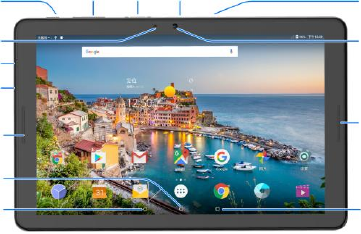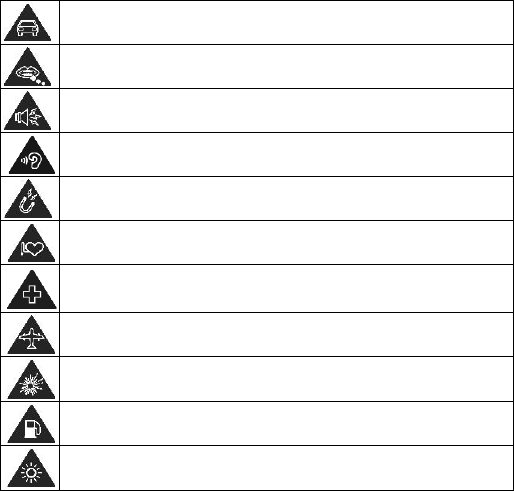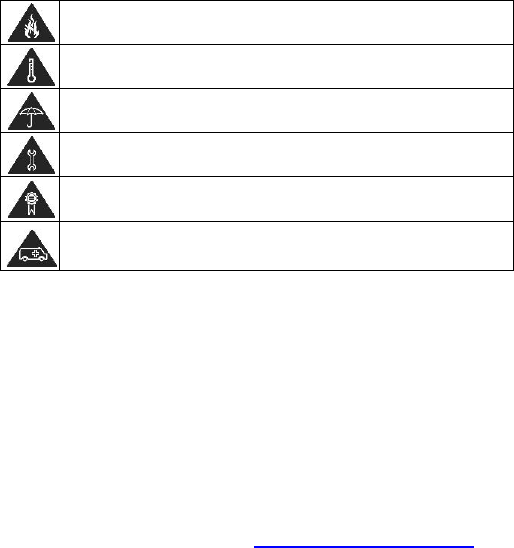ZTE K92 LTE/WCDMA Tablet User Manual K88 AT T Trek 2 HD User Guide
ZTE Corporation LTE/WCDMA Tablet K88 AT T Trek 2 HD User Guide
ZTE >
User manual
K92
User Guide
Copyright © 2017 ZTE CORPORATION. All rights reserved. ZTE and the
ZTE logos are trademarks of the ZTE Corporation. AT&T, the AT&T logo
and all other AT&T marks contained herein are trademarks of AT&T
Intellectual Property and/or AT&T.
No part of this publication may be excerpted, reproduced, translated or
utilized in any form or by any means, electronic or mechanical, including
photocopying and microfilm, without the prior written permission of ZTE
Corporation.
The manual is published by ZTE Corporation. We reserve the right to
make modifications on print errors or update specifications without prior
notice.
microSDXC is a trademark of SD, 3C-LLC. The Bluetooth® word mark and
logos are registered trademarks owned by Bluetooth SIG, Inc.
Manufactured under license from Dolby Laboratories. Dolby, Dolby Audio,
and the double-D symbol are trademarks of Dolby Laboratories.
Qualcomm and Snapdragon are trademarks of Qualcomm Incorporated,
registered in the United States and other countries. Used with permission.
Version No. : V1.0
Edition Time: April 2017
Getting Started
Installing the nano-SIM Card and the
microSDXC Card
You do not need to power off your tablet before installing or
replacing the nano-SIM card or before installing or removing the
microSDXC card (not included). You need to unmount the
microSDXC card before removing it (see Connecting to Networks
and Devices – Using the microSDXC Card as Portable or Internal
Storage).
Warning! To avoid damage to the tablet, please only use a
standard nano-SIM card. You can obtain a standard nano-SIM
card from your service provider.
1. Open the nano-SIM/microSDXC card cover on the back of
the tablet.
2. Insert the nano-SIM card into the nano-SIM card slot or the
microSDXC card (not included) into the microSDXC
card slot with the contacts facing down.
3. Close the cover.
Charging the Battery
Your tablet’s battery should have enough power for the tablet to
turn on and find a signal. You should fully charge the battery as
soon as possible.
If the battery is low, there will be a pop-up message on the screen.
As you charge your tablet, the screen will tell you the exact battery

level each time you wake up your tablet.
Warning! Use only ZTE-approved chargers and cables. The use of
unapproved accessories could damage your tablet or cause the
battery to explode.
Important: Do not change the built-in rechargeable battery in your
device by yourself. The battery can only be changed by ZTE or
ZTE authorized service provider.
1. Connect the adapter to the charging jack. Ensure the
adapter has the correct orientation before insertion. Do not
force the connector into the charging jack.
2. Connect the charger to a standard AC wall outlet. If the
tablet is on, you’ll see a charging icon, such as or ,
appear in the Status Bar.
3. Disconnect the charger when the battery is fully charged.
Note: If the battery is extremely low, you may be unable to power
on the tablet even when it is being charged. In this case, try again
after charging the tablet for at least 20 minutes. Contact customer
service if you still cannot power on the tablet after prolonged
charging.
Extending the Battery Life
Active applications, screen brightness levels, Bluetooth and Wi-Fi
usage, and GPS functionality can drain your battery. You can
follow the helpful tips below to conserve your battery power:
Reduce the screen backlight time.
Lower the screen brightness.
Turn auto-sync, Wi-Fi, and Bluetooth off when not in use.
Disable the GPS function when not in use. Most applications
using this function will periodically query the GPS satellites
for your current location; each query drains your battery.
Powering Your Tablet On/Off
Press and hold the Power key to power on your tablet.
To turn it off, press and hold the Power key to open the
options menu. Tap Power off.
Note: If the tablet freezes or takes too long to respond, press and
hold the Power key for about 10 seconds to power the tablet off.
Press and hold the Power key to turn the tablet on again.
Setting Up Your Tablet for the First Time
To set up the tablet, follow the on-screen prompts when you first
power on your tablet after you purchase it or after performing a
factory reset (see Settings – Device – Backup & reset).
1. Tap the language field to select the language you want,
and tap LTE’S GO.
2. Follow the prompts to set up your Wi-Fi connection,
Google account, Google services, and other options.
Locking/Unlocking the Screen and Keys
Your tablet allows you to quickly lock the screen and keys (put the
tablet into Sleep mode) when not in use and also to turn the
screen back on and unlock it when you need it.
Locking the Screen and Keys
To quickly turn the screen off and lock the keys, press the
Power key.
Note: To save battery power, the tablet automatically turns off the
screen after a certain period of time when you leave it idle. You
will still be able to receive notifications while the tablet screen is
off.
Unlocking the Screen and Keys
1. Press the Power key to turn the screen on.
2. Press and hold a blank area of the screen.
Note: If you have set an unlock pattern, PIN, or password for your
tablet (see Personalizing – Protecting Your Tablet With Screen
Locks), you’ll need to draw the pattern or enter the PIN/Password
to unlock your screen.
Using the Touch Screen
Your tablet’s touch screen lets you control actions through a
variety of touch gestures.
Tap – When you want to type using the on-screen keyboard,
select on-screen items (such as application and settings
icons), or press on-screen buttons, simply tap them with your
finger.
Press and Hold – To open the available options for an item
(for example, a message or link in a web page), press and
hold the item.
Swipe or Slide – To swipe or slide means to quickly drag
your finger vertically or horizontally across the screen.
Drag – To drag, press and hold your finger with some
pressure before you start to move your finger. While
dragging, do not release your finger until you have reached
the target position.
Pinch – In some apps (such as Maps and Gallery), you can
zoom in and out by placing two fingers on the screen at once
and pinching them together (to zoom out) or spreading them
apart (to zoom in).
Rotate the Screen – For most screens, you can automatically
change the screen orientation from portrait to landscape by
turning the tablet sideways.
Note: You can access the screen rotation control by sliding down
the Status Bar twice and tapping Auto-rotate.

Getting to Know Your Tablet
Volume key
Power/Lock key
DTV key
Microphone
nano-SIM/
microSDXC card
cover
Proximity
& light sensor
Headset jack
Charging/USB
Type-C™ jack
Speaker
Home key
Back key
Recent apps key
Speaker
Front camera

Key Functions
Key
Function
Power key
Press and hold to turn Airplane mode on
or off, to Restart, or to Power off.
Press to change your tablet to Sleep mode.
Press to wake up your tablet.
Home key
Press to return to the home screen from any
application or screen.
Press and hold to access Google Search™ or
Google Now™.
Recent apps
key
Press to see recently used applications.
Back key
Press to go to the previous screen.
Volume key
Press or hold to turn the volume up or down.
DTV key
Press to open a bound app.

Health and Safety Information
General Safety
Don’t use while driving. Never text while driving.
Small parts may cause choking.
Your device can produce a loud sound.
To prevent possible hearing damage, do not listen at high
volume levels for long periods.
Avoid contact with anything magnetic.
Keep away from pacemakers and other electronic medical
devices.
Turn off when asked to in hospitals and medical facilities.
Turn off when told to in aircrafts and airports.
Turn off when near explosive materials or liquids.
Don’t use at gas stations.
Your device may produce a bright or flashing light.

Don’t dispose of your device in fire.
Avoid extreme temperatures.
Avoid contact with liquids. Keep your device dry.
Do not attempt to disassemble your device.
Only use approved accessories.
Don’t rely on your tablet as a primary device for emergency
communications.
FCC RF Exposure Information (SAR)
This device is designed and manufactured not to exceed the
emission limits for exposure to radio frequency (RF) energy set by
the Federal Communications Commission of the United States.
The exposure standard for wireless employs a unit of
measurement known as the Specific Absorption Rate, or
SAR. The SAR limit set by the FCC is 1.6W/kg.
The FCC has granted an Equipment Authorization for this model
device with all reported SAR levels evaluated as in compliance
with the FCC RF exposure guidelines. SAR information on this
model device is on file with the FCC and can be found under the
Display Grant section of www.fcc.gov/oet/ea/fccid after
searching on FCC ID: SRQ-K92.
For this device, the highest reported SAR value for usage near the
body is 1.20 W/kg.
FCC Regulations
This device complies with part 15 of the FCC Rules. Operation is
subject to the following two conditions: (1) This device may not
cause harmful interference, and (2) this device must accept any
interference received, including interference that may cause
undesired operation.
This device has been tested and found to comply with the limits for
a Class B digital device, pursuant to Part 15 of the FCC Rules.
These limits are designed to provide reasonable protection
against harmful interference in a residential installation. This
equipment generates, uses and can radiate radio frequency
energy and, if not installed and used in accordance with the
instructions, may cause harmful interference to radio
communications. However, there is no guarantee that interference
will not occur in a particular installation. If this equipment does
cause harmful interference to radio or television reception, which
can be determined by turning the equipment off and on, the user is
encouraged to try to correct the interference by one or more of the
following measures:
Reorient or relocate the receiving antenna.
Increase the separation between the equipment and receiver.
Connect the equipment into an outlet on a circuit different from
that to which the receiver is connected.
Consult the dealer or an experienced radio/TV technician for
help.
CAUTION:
Changes or modifications not expressly approved by the party
responsible for compliance could void the user‘s authority to
operate the equipment.
CTIA
Do not disassemble or open, crush, bend or deform, puncture
or shred.
Do not modify or remanufacture, attempt to insert foreign
objects into the battery, immerse or expose to water or other
liquids, expose to fire, explosion or other hazard.
Only use the battery for the system for which it is specified.
Only use the battery with a charging system that has been
qualified with the system per CTIA Certification Requirements
for Battery System Compliance to IEEE 1725. Use of an
unqualified battery or charger may present a risk of fire,
explosion, leakage, or other hazard.
Do not short circuit a battery or allow metallic conductive
objects to contact battery terminals.
Replace the battery only with another battery that has been
qualified with the system per this standard, IEEE-Std-1725.
Use of an unqualified battery may present a risk of fire,
explosion, leakage or other hazard.
Promptly dispose of used batteries in accordance with local
regulations.
Battery usage by children should be supervised.
Avoid dropping the device or battery. If the device or battery is
dropped, especially on a hard surface, and the user suspects
damage, take it to a service center for inspection.
Improper battery use may result in a fire, explosion or other
hazard.
The device shall only be connected to CTIA certified adapters,
products that bear the USB-IF logo or products that have
completed the USB-IF compliance program.
Distraction
Driving
Full attention must be given to driving at all times in order to
reduce the risk of an accident. Using a wireless device while
driving (even with a hands-free kit) can cause distraction and lead
to an accident. You must comply with local laws and regulations
restricting the use of wireless devices while driving.
Operating Machinery
Full attention must be given to operating the machinery in order to
reduce the risk of an accident.
Product Handling
General Statement on Handling and Use
You alone are responsible for how you use your device and any
consequences of its use.
You must always power off your device wherever the use of a
wireless device is prohibited. Use of your device is subject to
safety measures designed to protect users and their environment.
Always treat your device and its accessories with care and
keep it in a clean and dust-free place.
Do not expose your device or its accessories to open flames or
lit tobacco products.
Do not expose your device or its accessories to liquid,
moisture, or high humidity.
Do not drop, throw, or try to bend your device or its
accessories.
Do not use harsh chemicals, cleaning solvents, or aerosols to
clean the device or its accessories.
Do not paint your device or its accessories.
Do not attempt to disassemble your device or its accessories.
Only authorized personnel can do so.
Do not expose your device or its accessories to extreme
temperatures, minimum 23 °F and maximum 122 °F (minimum
-5 °C and maximum +50 °C).
Please check local regulations for disposal of electronic
products.
Do not carry your device in your back pocket as it could break
when you sit down.
Small Children
Do not leave your device and its accessories within the reach of
small children or allow them to play with it. They could hurt
themselves or others, or could accidentally damage the device.
Your device contains small parts with sharp edges that may cause
an injury or may become detached and create a choking hazard.
Demagnetization
To avoid the risk of demagnetization, do not allow electronic
devices or magnetic media close to your device for a long time.
Electrostatic Discharge (ESD)
Do not touch the SIM card’s metal connectors.
Antenna
Do not touch the antenna unnecessarily.
Air Bags
Do not place the device in the area over an air bag or in the air bag
deployment area as an airbag inflates with great force and serious
injury could result.
Store the device safely before driving your vehicle.
Seizures/Blackouts
The device can produce a bright or flashing light. A small
percentage of people may be susceptible to blackouts or seizures
(even if they have never had one before) when exposed to
flashing lights or light patterns such as when playing games or
watching video. If you have experienced seizures or blackouts or
have a family history of such occurrences, please consult a
physician.
Repetitive Strain Injuries
To minimize the risk of Repetitive Strain Injury (RSI) when texting
or playing games with your device:
Do not grip the device too tightly.
Press the keys lightly.
Use the special features that are designed to minimize the
times of pressing buttons, such as Message Templates and
Predictive Text.
Take lots of breaks to stretch and relax.
Loud Noise
This device is capable of producing loud noises, which may
damage your hearing. Turn down the volume before using
headphones, Bluetooth stereo headsets or other audio devices.
Device Heating
Your device may become warm during charging and during normal
use.
Electrical Safety
Accessories
Use only approved accessories.
Do not connect with incompatible products or accessories.
Take care not to touch or allow metal objects, such as coins or key
rings, to contact or short-circuit in the battery terminals.
Connection to a Car
Seek professional advice when connecting a device interface to
the vehicle electrical system.
Faulty and Damaged Products
Do not attempt to disassemble the device or its accessories.
Only qualified personnel can service or repair the device or its
accessories.
If your device (or its accessories) has been submerged in water,
punctured, or subjected to a severe fall, do not use it until you
have taken it to be checked at an authorized service center.
Radio Frequency Interference
General Statement on Interference
Care must be taken when using the device in close proximity to
personal medical devices, such as pacemakers and hearing aids.
Pacemakers
Pacemaker manufacturers recommend that a minimum separation
of 6 inches (15 cm) be maintained between a mobile device and a
pacemaker to avoid potential interference with the pacemaker. To
achieve this, use the device on the opposite ear to your
pacemaker and do not carry it in a breast pocket.
Hearing Aids
People with hearing aids or other cochlear implants may
experience interfering noises when using wireless devices or
when one is nearby.
The level of interference will depend on the type of hearing device
and the distance from the interference source, increasing the
separation between them may reduce the interference. You may
also consult your hearing aid manufacturer to discuss alternatives.
Medical Devices
Please consult your doctor and the device manufacturer to
determine if operation of your device may interfere with the
operation of your medical device.
Hospitals
Power off your wireless device when requested to do so in
hospitals, clinics, or health care facilities. These requests are
designed to prevent possible interference with sensitive medical
equipment.
Aircraft
Power off your wireless device whenever you are instructed to do
so by airport or airline staff.
Consult the airline staff about the use of wireless devices on board
the aircraft. If your device offers a ‘flight mode’, this must be
enabled prior to boarding an aircraft.
Interference in Cars
Please note that because of possible interference to electronic
equipment, some vehicle manufacturers forbid the use of mobile
devices in their vehicles unless a hands-free kit with an external
antenna is included in the installation.
Explosive Environments
Gas Stations and Explosive Atmospheres
In locations with potentially explosive atmospheres, obey all
posted signs to turn off wireless devices such as your tablet or
other radio equipment.
Areas with potentially explosive atmospheres include fueling
areas, below decks on boats, fuel or chemical transfer or storage
facilities, and areas where the air contains chemicals or particles,
such as grain, dust, or metal powders.
Blasting Caps and Areas
Power off your mobile device or wireless device when in a blasting
area or in areas posted with power off “two-way radios” or
“electronic devices” notices to avoid interfering with blasting
operations.